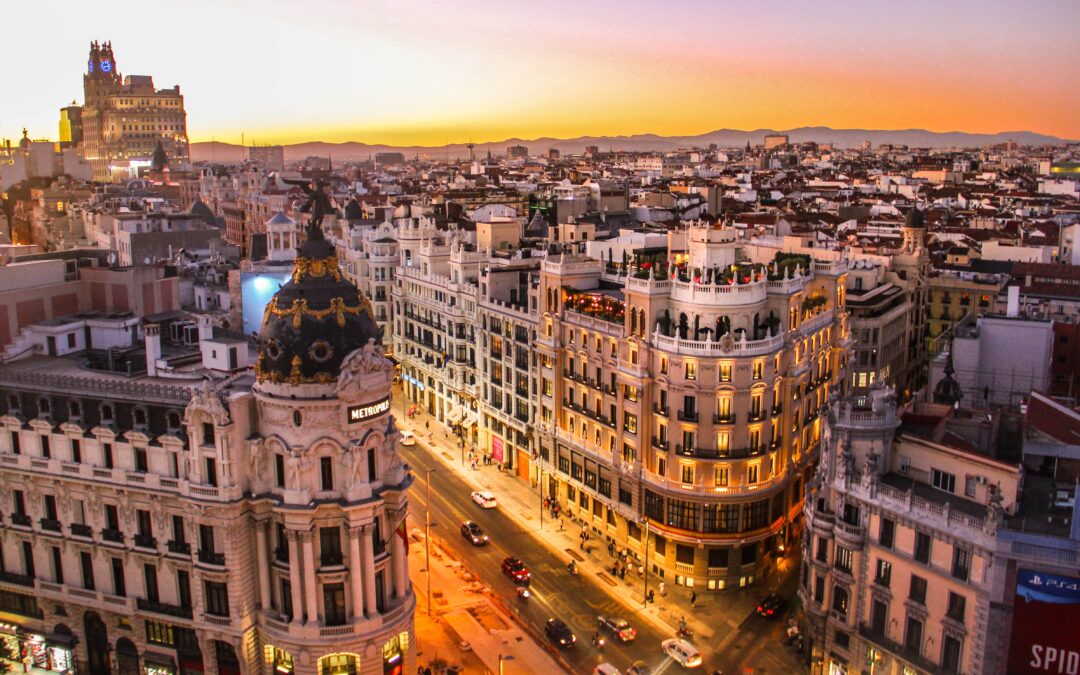Blog Post Written by Kathryn Walton – Events and Communications Assistant
This year, World Cities Day will be observed by the United Nations under the theme “act local to go global,” to explore what local action succeeded and what is still needed to empower local and regional governments to create greener, more equitable, and sustainable cities. Given that climate change is one of the greatest global challenges that we face, materialising in many forms, it is increasingly important to tackle the issue both globally and locally with innovative solutions. What’s more, cities are a key contributor to climate change as they are energy intensive and emit a high percentage of greenhouse gases. However, as much as they are an element of the crisis, cities also have the potential to act as a solution. In line with the theme, at the Spanish Chamber of Commerce we were eager to reflect on the work of both local and government bodies in Spain and the UK, that has allowed Madrid and London to rank highly as two of the most sustainable and green capital cities in Europe, with a particular focus on green infrastructure initiatives.
MADRID
When looking at the city’s green credentials, there are certain aspects that stand out. In Madrid’s case, it is almost impossible to disregard the lung of the city – El Parque del Buen Retiro. Since its initial establishment in the 17th century outside of the city, the park now boasts more than 125 hectares and is situated in the urban centre following the city’s expansion. Nevertheless, aside from being a popular retreat for tourists and locals, El Retiro provides some serious environmental benefits including fighting pollution, promoting biodiversity, and mitigating high temperatures. The latter is a topic that is continually on the agenda of city boards and governments due to the “urban heat island,” a phenomenon that transpires due to the replacement of natural environments with dense concentrations of pavements, buildings, and other surfaces that absorb and retain heat. What’s more, Madrid has an abundance of smaller green areas all over the city that contribute to the fight against climate change.
Despite the fact that Madrid is already a notably green city, the community plans to go above and beyond to lead the fight against climate change. In September 2019, The Madrid 360 Environmental Sustainability Strategy Roadmap was established to identify and develop “actions especially relevant to Madrid 360 in terms of reducing greenhouse gas emissions in order to stop, revert, and mitigate the effects of Climate Change.” A significant component of this plan regards the creation of the Madrid Metropolitan Forest or ‘El Bosque Metropolitano.’ It is one of twelve large-scale projects championed to “boost the economy, employment, the environment and social cohesion of the Plan, and the priority of the Madrid City Council for the mobilisation of funds from the Recovery and Resilience Mechanism.” This will constitute 75km of green infrastructure connecting the protected natural areas of El Pardo, in the North, to Manzanares and Jarama in the Southeast. The resultant environmental impact will be relatively significant for the city, especially since the forest will cover around 14,200 hectares of land and comprise 450,000 trees. It will also inadvertently create cycle and pedestrian routes, as well as an ecological belt that will absorb the city’s carbon dioxide and have a cooling effect.
LONDON
London boasts a notable amount of green infrastructure relative to its size. In fact, roughly 60% of the city “is open land and 47% of Greater London is green.” Green spaces are certainly not lacking in the city, with an estimate of “3,000 parks, 142 local nature reserves”, and 3.8 million private gardens. What’s more, in 2019, the Mayor of London signed a charter that named London the first National Park City. The movement itself consists of a number of targets that include connecting citizens to the outdoors, promoting the “rich cultural life enabled by the outdoors,” establishing more high-quality blue and green spaces, and inspiring other cities to follow suit. The movement is underlined by a consensus of collaboration between government bodies, citizens, and organisations, with everyone playing their part to contribute to the plight against climate change as opposed to a top-down approach, governed by a single authority.
As a part of his ‘London Environment Strategy,’ the Mayor of London stressed the role of Londoners in “maintaining and enhancing the ecology of the city.” A large proportion of the city’s population acknowledge the immediate benefits of maintaining green spaces in the city. The impressive impact of urban green spaces on the National Health Service (NHS) cannot be understated; particularly that they save the public body around £950 million per year. This “comprises £370m per year saved on mental health costs, and £582m physical health savings.” The vast green spaces were especially valuable during the Covid-19 Pandemic, helping to mitigate some of the strain on the NHS.
Although there is still a long way to go in the fight against climate change, these two cities are certainly making substantial progress and acting as pioneers in the green revolution.
SOURCES
1. https://bit.ly/3M90Qr5
2. https://bit.ly/3fMxT8h
3. https://bit.ly/3CyjqFG
4. https://bit.ly/3CdmgOS
5. https://bit.ly/3EjmiYl
6. https://bit.ly/3EvlPCy
7. https://bit.ly/3ekOIqt
8. https://bit.ly/3enG8XN








